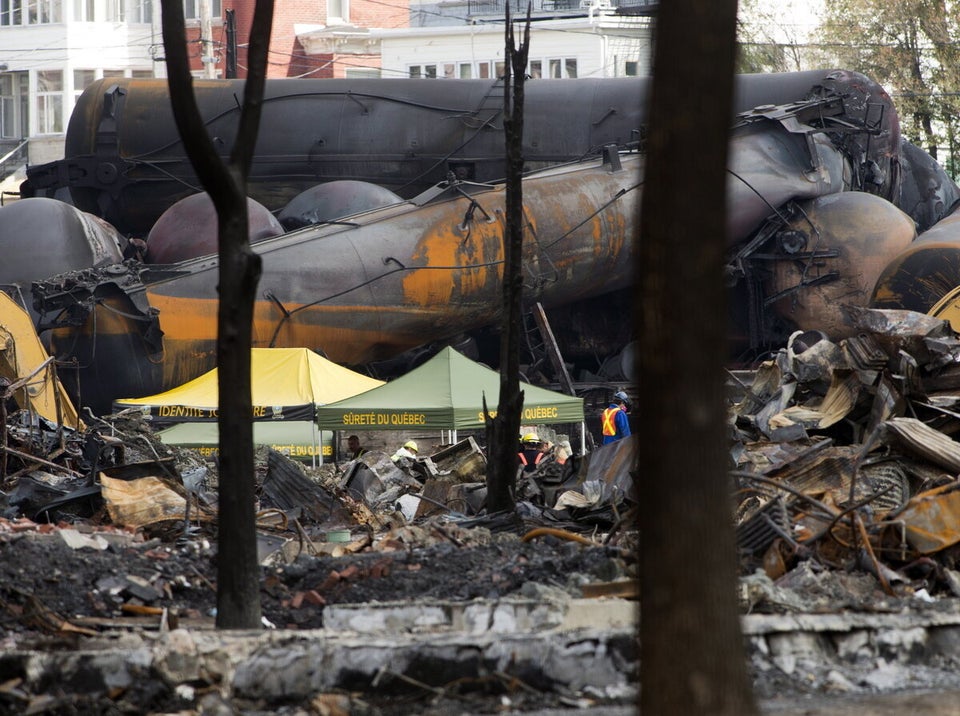
This weekend's tragic rail disaster in Lac Megantic, Quebec, should serve as a reminder that there is no completely safe method of transporting oil, gas and other volatile substances. There are just magnitudes of risk.
Research consistently indicates that rail is statistically safer than tanker truck; pipeline is statistically safer than rail. Even the Washington, D.C.-based Association of American Railways, representing the U.S. rail industry notes that rail accounts for almost three times the number of spills experienced by pipelines. The U.S. State Department noted the same thing in their recent Keystone assessment.
Less than two weeks ago I was in North Dakota, home of the vast Bakken Field, said to be the source of the crude that ignited Lac Megantic's night sky. It is quite possible I saw the very same 73 jet-black pressurized tanker cars that that reportedly uncoupled, rolled and ultimately wrecked such havoc upon the picturesque lakeside town. Over a two-day period, I observed more than a half-dozen of these trains lumbering slowly eastwards, each with 70 to 80 tanker cars in tow.
The magnitude of the oil boom in North Dakota is difficult to express -- except perhaps to people who have experienced it themselves by living in places like Fort McMurray, Alberta. As I drove along I-94, local radio stations ran ads asking people to "just pull on over and come to work." Everywhere I looked pre-fabricated homes and apartment were rising out of the Great Plains as quickly as the very wheat crops they were replacing.
While much attention has been given to the proposed Keystone pipeline, designed to bring crude from Alberta to refineries in the U.S. gulf region, much less has been written about the increased movement of oil by rail to facilities like the Irving Oil refinery in Saint John, New Brunswick. It is one of the reasons the Montreal, Maine & Atlantic Railway exists -- and why it refurbished track to create a short-cut route across Maine to the New Brunswick coast.
The simple truth is that without increased pipeline capacity from east to west (and from north to south -- Keystone), greater volumes of oil will be moving via rail, be it from North Dakota to Atlantic Canada or from Alberta to elsewhere in Canada and to the U.S. In a report issued April 2 by RBC Capital Markets, it is predicted that failure to build the Keystone Pipeline alone will mean that rail shipments in Canada will rise an additional 42 per cent by 2017.
Blog continues below slideshow...
Many opponents of Keystone and other pipelines argue that facilitating the transport of oil by any means is just extending a dependency on a carbon-heavy energy source that needs to be phased out as quickly as possible. This seems like an attractive thesis, at least until one that looks more closely at the practicality of bringing enough alternative energy sources online quickly enough to take up the slack.
For example, there is much talk in the U.S. of replacing gasoline and diesel with electric vehicles. Which would be great, if it weren't for the fact the a huge percentage of American electricity is produced from coal -- which, when it comes to carbon emissions, makes so-called "dirty oil" look pristine in comparison. And where does much of the coal plant emission end up? Thanks to prevailing winds, in places like Quebec and Ontario.
Both Canada and, especially, the U.S., need to curb carbon emissions and step away from their addiction to fossil fuels. But will blocking new pipelines in the U.S. or across Canada lead to a faster end to this addiction? Or will it simply lead to the substitution of rail transport -- by most measures relatively safe, but statistically not as safe as pipelines? These are valid questions on both sides of the border and ones brought into sharp focus by Lac Megantic.
